Comparison of Hydraulic Travel Time and Attenuation Inversions, Thermal Tracer Tomography and Geostatistical Inversion for Aquifer Characterization: A Numerical Study
Abstract
1. Introduction
2. Inverse Approach
2.1. Hydraulic Travel Time Inversion and Attenuation Inversion
2.2. Travel Time-Based Thermal Tracer Tomography
2.3. Geostatistical Inversion
3. Numerical Modeling
3.1. Aquifer Analogue Data
3.2. Modelling Setup
3.3. Simulated Tests and Data Utilized
4. Results and Discussion
4.1. Hydraulic Travel Time and Attenuation Inversion
4.2. Inverted Distribution by the Thermal Tracer Tomography
4.3. Geostatistical Inversion
5. Conclusions
Author Contributions
Funding
Data Availability Statement
Acknowledgments
Conflicts of Interest
References
- Alexander, M.; Berg, S.J.; Illman, W.A. Field Study of Hydrogeologic Characterization Methods in a Heterogeneous Aquifer. Groundwater 2011, 49, 365–382. [Google Scholar] [CrossRef]
- Salamon, P.; Fernàndez-Garcia, D.; Gómez-Hernández, J.J. Modeling Tracer Transport at the MADE Site: The Importance of Heterogeneity. Water Resour. Res. 2007, 43, W08404. [Google Scholar] [CrossRef]
- Luo, N.; Zhao, Z.; Illman, W.A.; Berg, S.J. Comparative Study of Transient Hydraulic Tomography with Varying Parameterizations and Zonations: Laboratory Sandbox Investigation. J. Hydrol. 2017, 554, 758–779. [Google Scholar] [CrossRef]
- Luo, N.; Illman, W.A.; Zha, Y.; Park, Y.-J.; Berg, S.J. Three-Dimensional Hydraulic Tomography Analysis of Long-Term Municipal Wellfield Operations: Validation with Synthetic Flow and Solute Transport Data. J. Hydrol. 2020, 590, 125438. [Google Scholar] [CrossRef]
- Zhao, Z.; Illman, W.A. On the Importance of Considering Specific Storage Heterogeneity in Hydraulic Tomography: Laboratory Sandbox and Synthetic Studies. J. Hydrol. 2021, 593, 125874. [Google Scholar] [CrossRef]
- Day-Lewis, F.D.; Harris, J.M.; Gorelick, S.M. Time-lapse Inversion of Crosswell Radar Data. Geophysics 2002, 67, 1740–1752. [Google Scholar] [CrossRef]
- Robinson, J.; Slater, L.; Johnson, T.; Shapiro, A.; Tiedeman, C.; Ntarlagiannis, D.; Johnson, C.; Day-Lewis, F.; Lacombe, P.; Imbrigiotta, T.; et al. Imaging Pathways in Fractured Rock Using Three-Dimensional Electrical Resistivity Tomography. Groundwater 2016, 54, 186–201. [Google Scholar] [CrossRef]
- Brauchler, R. Derivation of Site-specific Relationships between Hydraulic Parameters and P-wave Velocities Based on Hydraulic and Seismic Tomography. Water Resour. Res. 2012, 14, W03531. [Google Scholar] [CrossRef]
- Bohling, G.C.; Zhan, X.; Butler, J.J., Jr.; Zheng, L. Steady Shape Analysis of Tomographic Pumping Tests for Characterization of Aquifer Heterogeneities. Water Resour. Res. 2002, 38, 60-1–60-15. [Google Scholar] [CrossRef]
- Qiu, P.; Hu, R.; Hu, L.; Liu, Q.; Xing, Y.; Yang, H.; Qi, J.; Ptak, T. A Numerical Study on Travel Time Based Hydraulic Tomography Using the SIRT Algorithm with Cimmino Iteration. Water 2019, 11, 909. [Google Scholar] [CrossRef]
- Yeh, T.-C.J.; Liu, S. Hydraulic Tomography: Development of a New Aquifer Test Method. Water Resour. Res. 2000, 36, 2095–2105. [Google Scholar] [CrossRef]
- Zhu, J.; Yeh, T.-C.J. Analysis of Hydraulic Tomography Using Temporal Moments of Drawdown Recovery Data. Water Resour. Res. 2006, 42, W02403. [Google Scholar] [CrossRef]
- Brauchler, R.; Liedl, R.; Dietrich, P. A Travel Time Based Hydraulic Tomographic Approach. Water Resour. Res. 2003, 39, 1370. [Google Scholar] [CrossRef]
- Illman, W.A.; Berg, S.J.; Zhao, Z. Should Hydraulic Tomography Data Be Interpreted Using Geostatistical Inverse Modeling? A Laboratory Sandbox Investigation. Water Resour. Res. 2015, 51, 3219–3237. [Google Scholar] [CrossRef]
- Illman, W.A.; Berg, S.J.; Yeh, T.-C.J. Comparison of Approaches for Predicting Solute Transport: Sandbox Experiments. Groundwater 2012, 50, 421–431. [Google Scholar] [CrossRef]
- Illman, W.A.; Zhu, J.; Craig, A.J.; Yin, D. Comparison of Aquifer Characterization Approaches through Steady State Groundwater Model Validation: A Controlled Laboratory Sandbox Study. Water Resour. Res. 2010, 46, W04502. [Google Scholar] [CrossRef]
- Illman, W.A.; Liu, X.; Craig, A. Steady-State Hydraulic Tomography in a Laboratory Aquifer with Deterministic Heterogeneity: Multi-Method and Multiscale Validation of Hydraulic Conductivity Tomograms. J. Hydrol. 2007, 341, 222–234. [Google Scholar] [CrossRef]
- Liu, S.; Yeh, T.-C.J.; Gardiner, R. Effectiveness of Hydraulic Tomography: Sandbox Experiments. Water Resour. Res. 2002, 38, 5-1–5-9. [Google Scholar] [CrossRef]
- Liu, X.; Illman, W.A.; Craig, A.J.; Zhu, J.; Yeh, T.-C.J. Laboratory Sandbox Validation of Transient Hydraulic Tomography. Water Resour. Res. 2007, 43, W05404. [Google Scholar] [CrossRef]
- Yin, D.; Illman, W.A. Hydraulic Tomography Using Temporal Moments of Drawdown Recovery Data: A Laboratory Sandbox Study. Water Resour. Res. 2009, 45, W01502. [Google Scholar] [CrossRef]
- Berg, S.J.; Illman, W.A. Three-Dimensional Transient Hydraulic Tomography in a Highly Heterogeneous Glaciofluvial Aquifer-Aquitard System. Water Resour. Res. 2011, 47, W10507. [Google Scholar] [CrossRef]
- Bohling, G.C.; Butler, J.J., Jr.; Zhan, X.; Knoll, M.D. A Field Assessment of the Value of Steady Shape Hydraulic Tomography for Characterization of Aquifer Heterogeneities. Water Resour. Res. 2007, 43, W05430. [Google Scholar] [CrossRef]
- Brauchler, R.; Hu, R.; Hu, L.; Jimenez, S.; Bayer, P.; Dietrich, P.; Ptak, T. Rapid Field Application of Hydraulic Tomography for Resolving Aquifer Heterogeneity in Unconsolidated Sediments. Water Resour. Res. 2013, 49, 2013–2024. [Google Scholar] [CrossRef]
- Cardiff, M.; Zhou, Y.; Barrash, W.; Kitanidis, P.K. Aquifer Imaging with Oscillatory Hydraulic Tomography: Application at the Field Scale. Groundwater 2020, 58, 710–722. [Google Scholar] [CrossRef] [PubMed]
- Zha, Y.; Yeh, T.-C.J.; Illman, W.A.; Tanaka, T.; Bruines, P.; Onoe, H.; Saegusa, H. What Does Hydraulic Tomography Tell Us about Fractured Geological Media? A Field Study and Synthetic Experiments. J. Hydrol. 2015, 531, 17–30. [Google Scholar] [CrossRef]
- Zhao, Z.; Illman, W.A. Three-Dimensional Imaging of Aquifer and Aquitard Heterogeneity via Transient Hydraulic Tomography at a Highly Heterogeneous Field Site. J. Hydrol. 2018, 559, 392–410. [Google Scholar] [CrossRef]
- Vasco, D.W.; Keers, H.; Karasaki, K. Estimation of Reservoir Properties Using Transient Pressure Data: An Asymptotic Approach. Water Resour. Res. 2000, 36, 3447–3465. [Google Scholar] [CrossRef]
- Vasco, D.W.; Datta-Gupta, A. Asymptotic Solutions for Solute Transport: A Formalism for Tracer Tomography. Water Resour. Res. 1999, 35, 98WR02742. [Google Scholar] [CrossRef]
- Kitanidis, P.K. Quasi-Linear Geostatistical Theory for Inversing. Water Resour. Res. 1995, 31, 2411–2419. [Google Scholar] [CrossRef]
- Xiang, J.; Yeh, T.-C.J.; Lee, C.-H.; Hsu, K.-C.; Wen, J.-C. A Simultaneous Successive Linear Estimator and a Guide for Hydraulic Tomography Analysis. Water Resour. Res. 2009, 45, W02432. [Google Scholar] [CrossRef]
- Qiu, H.; Hu, R.; Luo, N.; Illman, W.A.; Hou, X. Comparison of Travel-Time and Geostatistical Inversion Approaches for Hydraulic Tomography: Synthetic Modeling Study on Data Density and Well Configuration Issues. J. Hydrol. 2023, 618, 129247. [Google Scholar] [CrossRef]
- Vasco, D.W.; Karasaki, K. Interpretation and Inversion of Low-Frequency Head Observations. Water Resour. Res. 2006, 42, W05408. [Google Scholar] [CrossRef]
- Brauchler, R.; Hu, R.; Dietrich, P.; Sauter, M. A Field Assessment of High-Resolution Aquifer Characterization Based on Hydraulic Travel Time and Hydraulic Attenuation Tomography. Water Resour. Res. 2011, 47, W03503. [Google Scholar] [CrossRef]
- Brauchler, R.; Cheng, J.-T.; Dietrich, P.; Everett, M.; Johnson, B.; Liedl, R.; Sauter, M. An Inversion Strategy for Hydraulic Tomography: Coupling Travel Time and Amplitude Inversion. J. Hydrol. 2007, 345, 184–198. [Google Scholar] [CrossRef]
- Hu, R. Hydraulic Tomography: A New Approach Coupling Hydraulic Travel Time, Attenuation and Steady Shape Inversions for High-Spatial Resolution Aquifer Characterization. Ph.D. Thesis, Universität Göttingen, Göttingen, Germany, 2011. Available online: https://ediss.uni-goettingen.de/handle/11858/00-1735-0000-0006-B2F7-E (accessed on 27 June 2023).
- Jiménez, S.; Brauchler, R.; Bayer, P. A New Sequential Procedure for Hydraulic Tomographic Inversion. Adv. Water Resour. 2013, 62, 59–70. [Google Scholar] [CrossRef]
- Anderson, M.P. Heat as a Ground Water Tracer. Groundwater 2005, 43, 951–968. [Google Scholar] [CrossRef]
- Hermans, T.; Wildemeersch, S.; Jamin, P.; Orban, P.; Brouyère, S.; Dassargues, A.; Nguyen, F. Quantitative Temperature Monitoring of a Heat Tracing Experiment Using Cross-Borehole ERT. Geothermics 2015, 53, 14–26. [Google Scholar] [CrossRef]
- Sarris, T.S.; Close, M.; Abraham, P. Using Solute and Heat Tracers for Aquifer Characterization in a Strongly Heterogeneous Alluvial Aquifer. J. Hydrol. 2018, 558, 55–71. [Google Scholar] [CrossRef]
- Lee, J.; Kokkinaki, A.; Kitanidis, P.K. Fast Large-Scale Joint Inversion for Deep Aquifer Characterization Using Pressure and Heat Tracer Measurements. Transp. Porous Med. 2018, 123, 533–543. [Google Scholar] [CrossRef]
- Ringel, L.; Somogyvári, M.; Jalali, M.; Bayer, P. Comparison of Hydraulic and Tracer Tomography for Discrete Fracture Network Inversion. Geosciences 2019, 9, 274. [Google Scholar] [CrossRef]
- Schwede, R.L.; Li, W.; Leven, C.; Cirpka, O.A. Three-Dimensional Geostatistical Inversion of Synthetic Tomographic Pumping and Heat-Tracer Tests in a Nested-Cell Setup. Adv. Water Resour. 2014, 63, 77–90. [Google Scholar] [CrossRef]
- Somogyvári, M.; Bayer, P.; Brauchler, R. Travel-Time-Based Thermal Tracer Tomography. Hydrol. Earth Syst. Sci. 2016, 20, 1885–1901. [Google Scholar] [CrossRef]
- Somogyvári, M.; Kühn, M.; Reich, S. Reservoir-Scale Transdimensional Fracture Network Inversion. Adv. Geosci. 2019, 49, 207–214. [Google Scholar] [CrossRef]
- Somogyvári, M.; Bayer, P. Field Validation of Thermal Tracer Tomography for Reconstruction of Aquifer Heterogeneity. Water Resour. Res. 2017, 53, 5070–5084. [Google Scholar] [CrossRef]
- Liu, Q.; Hu, R.; Hu, L.; Xing, Y.; Qiu, P.; Yang, H.; Fischer, S.; Ptak, T. Investigation of Hydraulic Properties in Fractured Aquifers Using Cross-Well Travel-Time Based Thermal Tracer Tomography: Numerical and Field Experiments. J. Hydrol. 2022, 609, 127751. [Google Scholar] [CrossRef]
- Illman, W.; Yeh, J.-J. Fusion of Tomography Tests for DNAPL Source Zone Characterization: Technology Development and Validation. Final Report No. Project ER-1365. SERDP. 2011, p. 450. Available online: https://serdp-estcp.org/Program-Areas/ (accessed on 27 June 2023).
- Rücker, C.; Günther, T.; Wagner, F.M. PyGIMLi: An Open-Source Library for Modelling and Inversion in Geophysics. Comput. Geosci. 2017, 109, 106–123. [Google Scholar] [CrossRef]
- Yeh, T.-C.J.; Jin, M.; Hanna, S. An Iterative Stochastic Inverse Method: Conditional Effective Transmissivity and Hydraulic Head Fields. Water Resour. Res. 1996, 32, 85–92. [Google Scholar] [CrossRef]
- Bayer, P. Aquifer-Analog-Studie in Grobklastischen ‘Braided River’Ablagerungen: Sedimentäre/Hydrogeologische Wandkartierung und Kalibrierung von Georadarmessungen—Diplomkartierung. Master’s Thesis, Universitaet Tuebingen, Tübingen, Germany, 2000. [Google Scholar]
- Liu, Q.; Hu, L.; Bayer, P.; Xing, Y.; Qiu, P.; Ptak, T.; Hu, R. A Numerical Study of Slug Tests in a Three-Dimensional Heterogeneous Porous Aquifer Considering Well Inertial Effects. Water Resour. Res. 2020, 56, e2020WR027155. [Google Scholar] [CrossRef]
- Ma, R.; Zheng, C. Effects of Density and Viscosity in Modeling Heat as a Groundwater Tracer. Groundwater 2010, 48, 380–389. [Google Scholar] [CrossRef]
- Hu, R.; Liu, Q.; Xing, Y. Case Study of Heat Transfer during Artificial Ground Freezing with Groundwater Flow. Water 2018, 10, 1322. [Google Scholar] [CrossRef]
- Hou, X.; Hu, R.; Yeh, T.J.; Li, Y.; Qi, J.; Song, Y.; Qiu, H. A Short-Term Pumping Strategy for Hydraulic Tomography Based on the Successive Linear Estimator. Water Resour. Res. 2023, 59, e2022WR033831. [Google Scholar] [CrossRef]
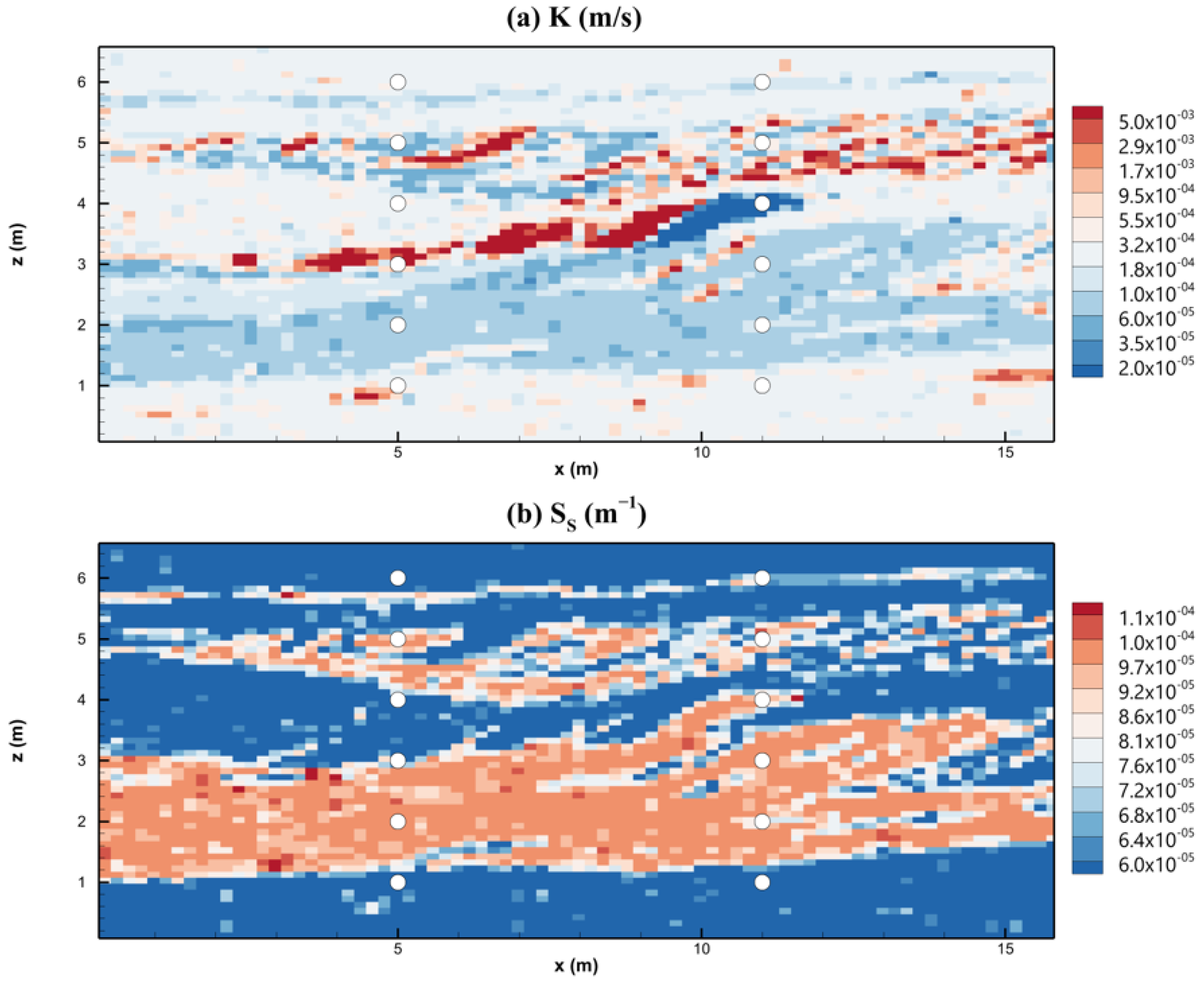
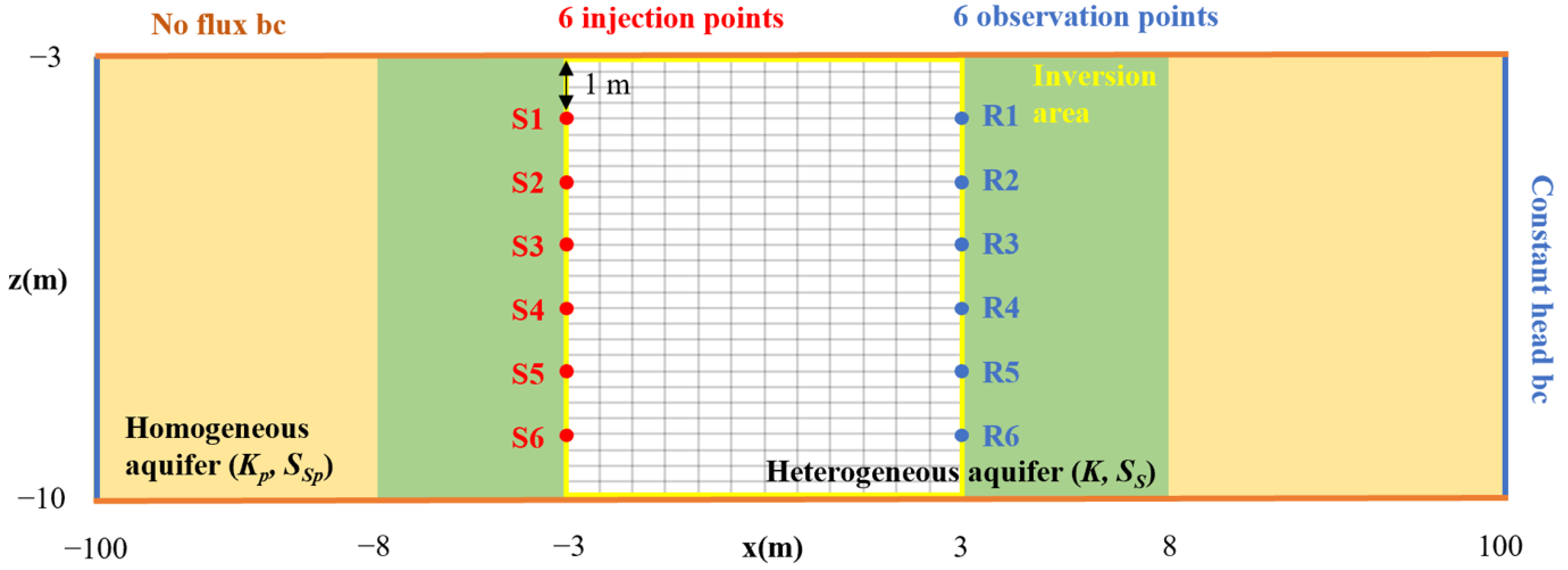
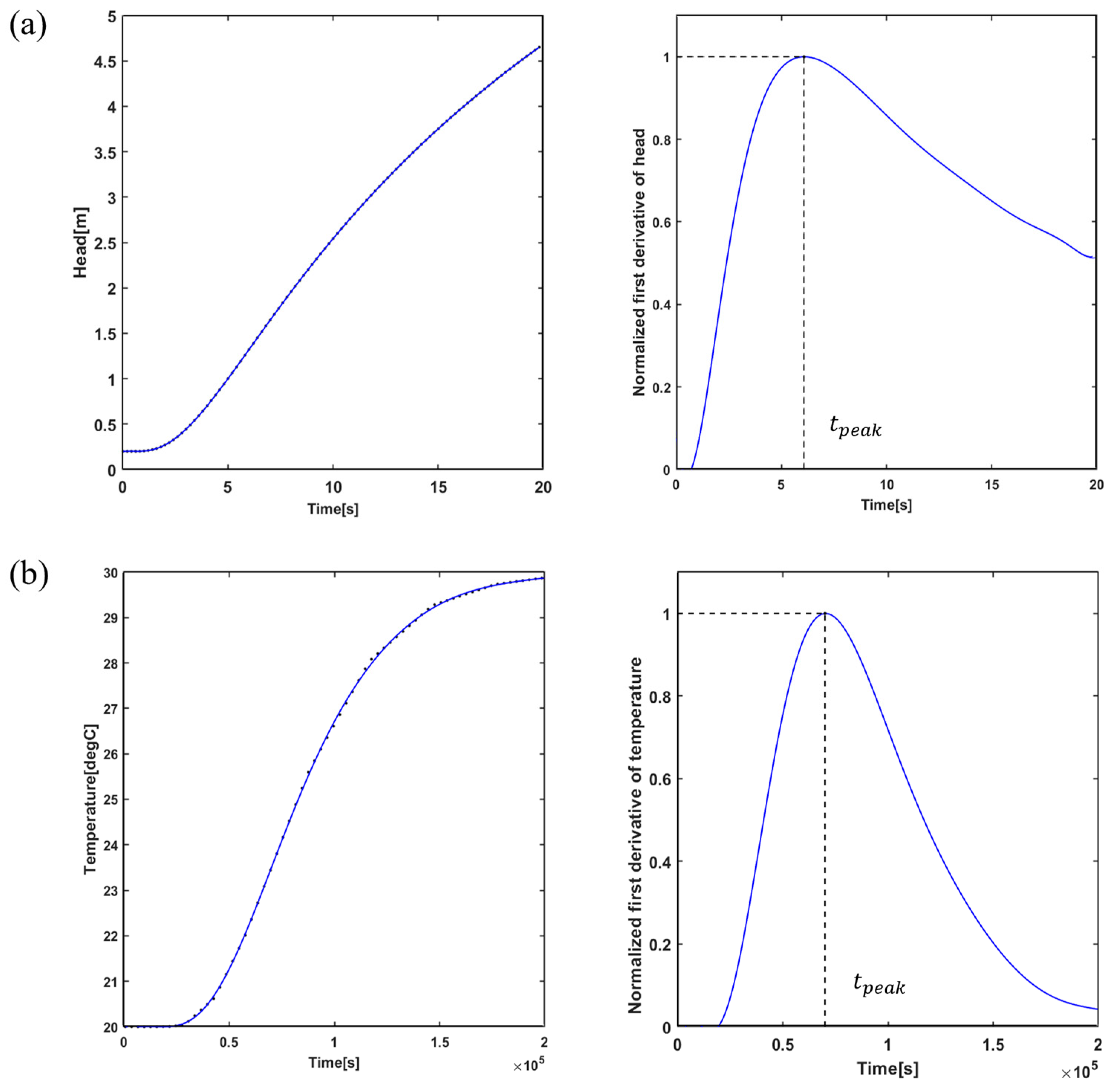
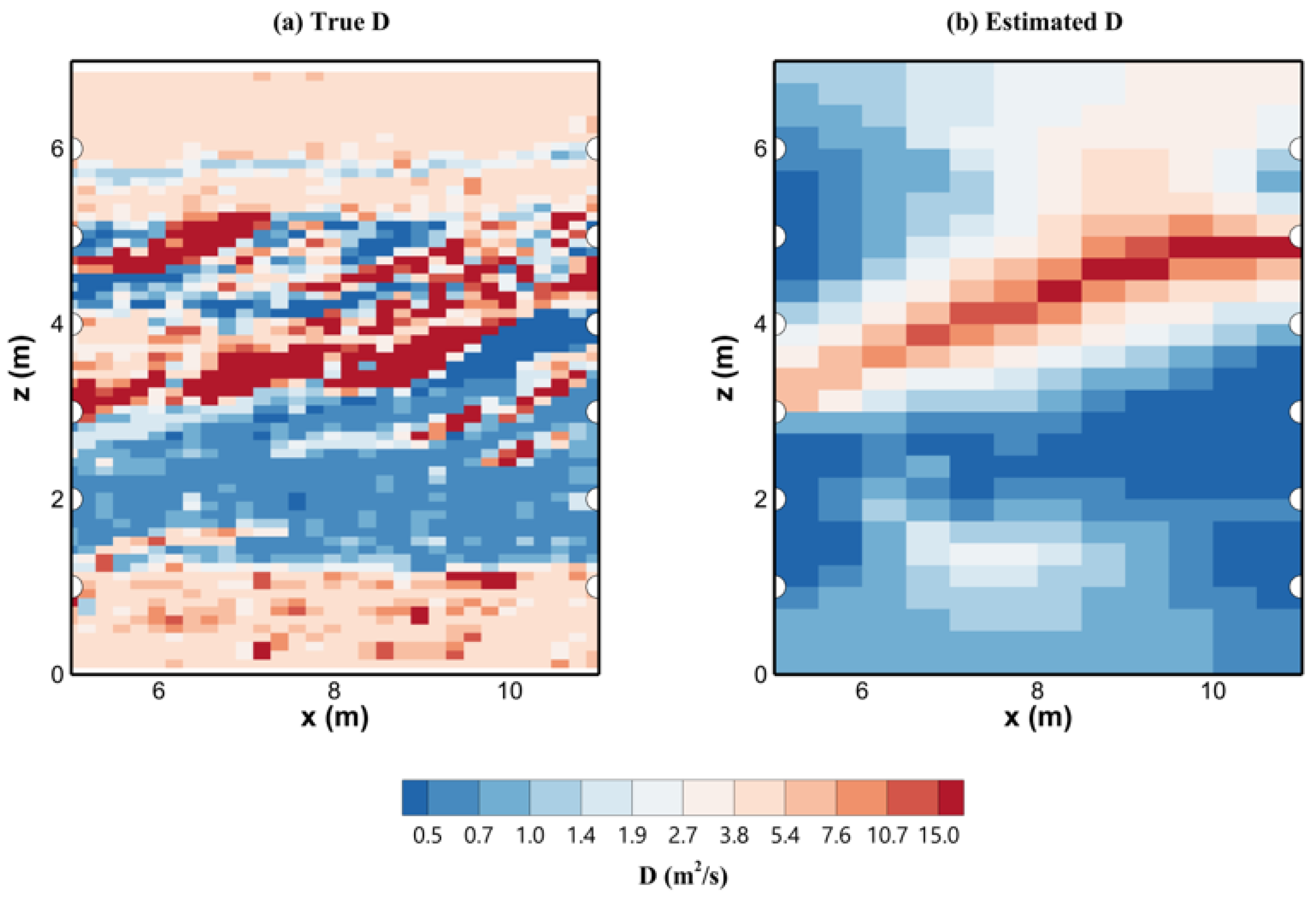
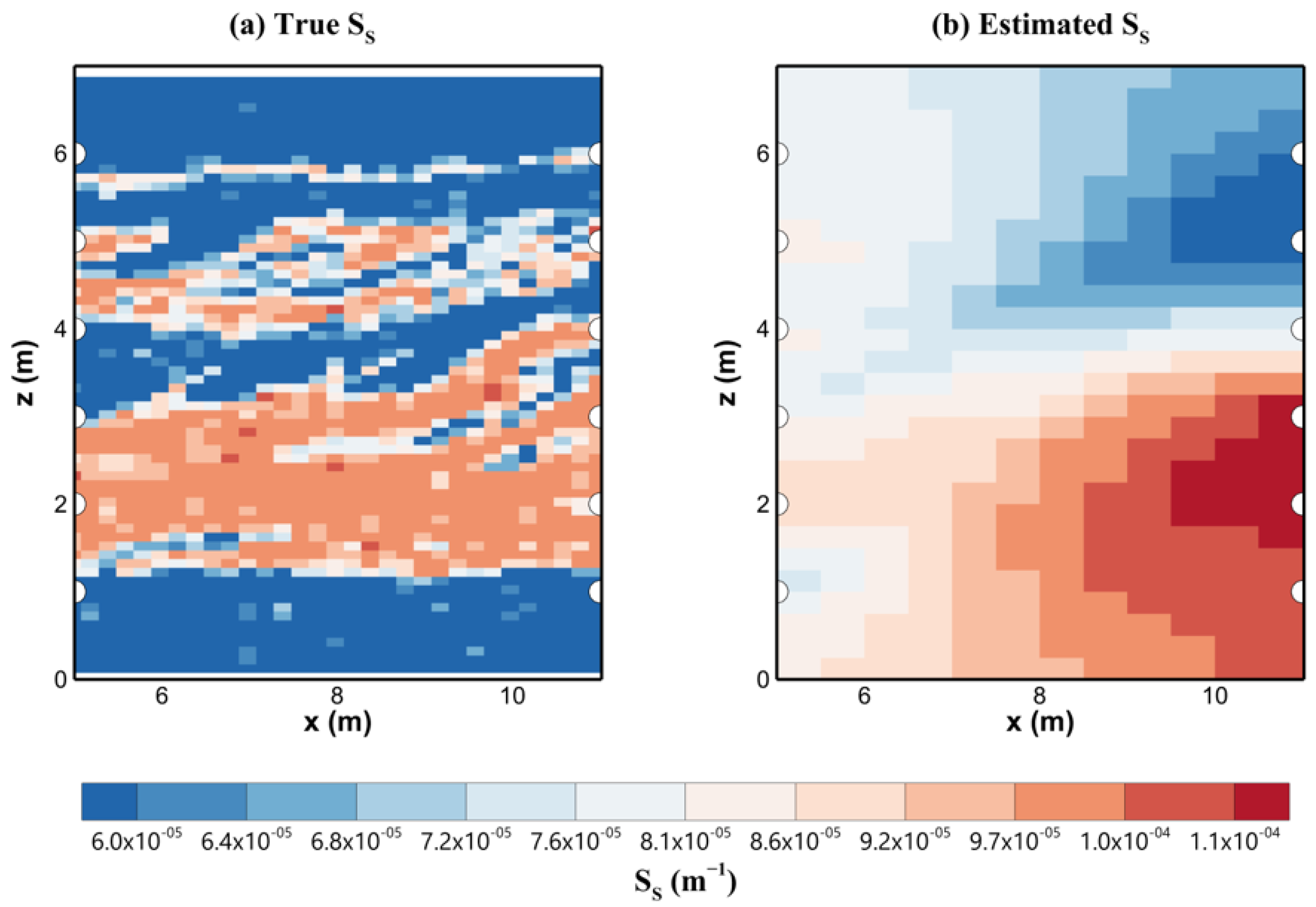

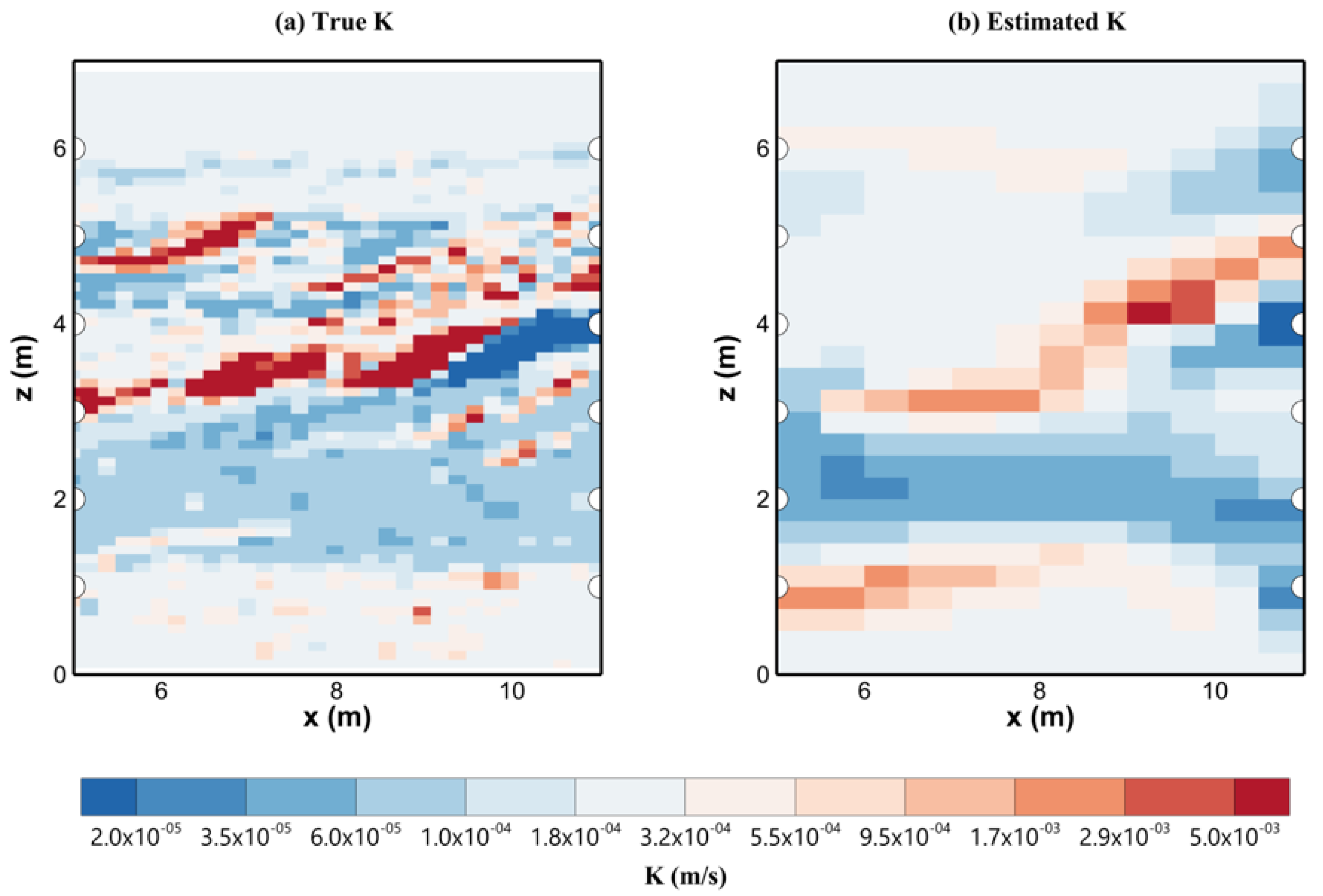
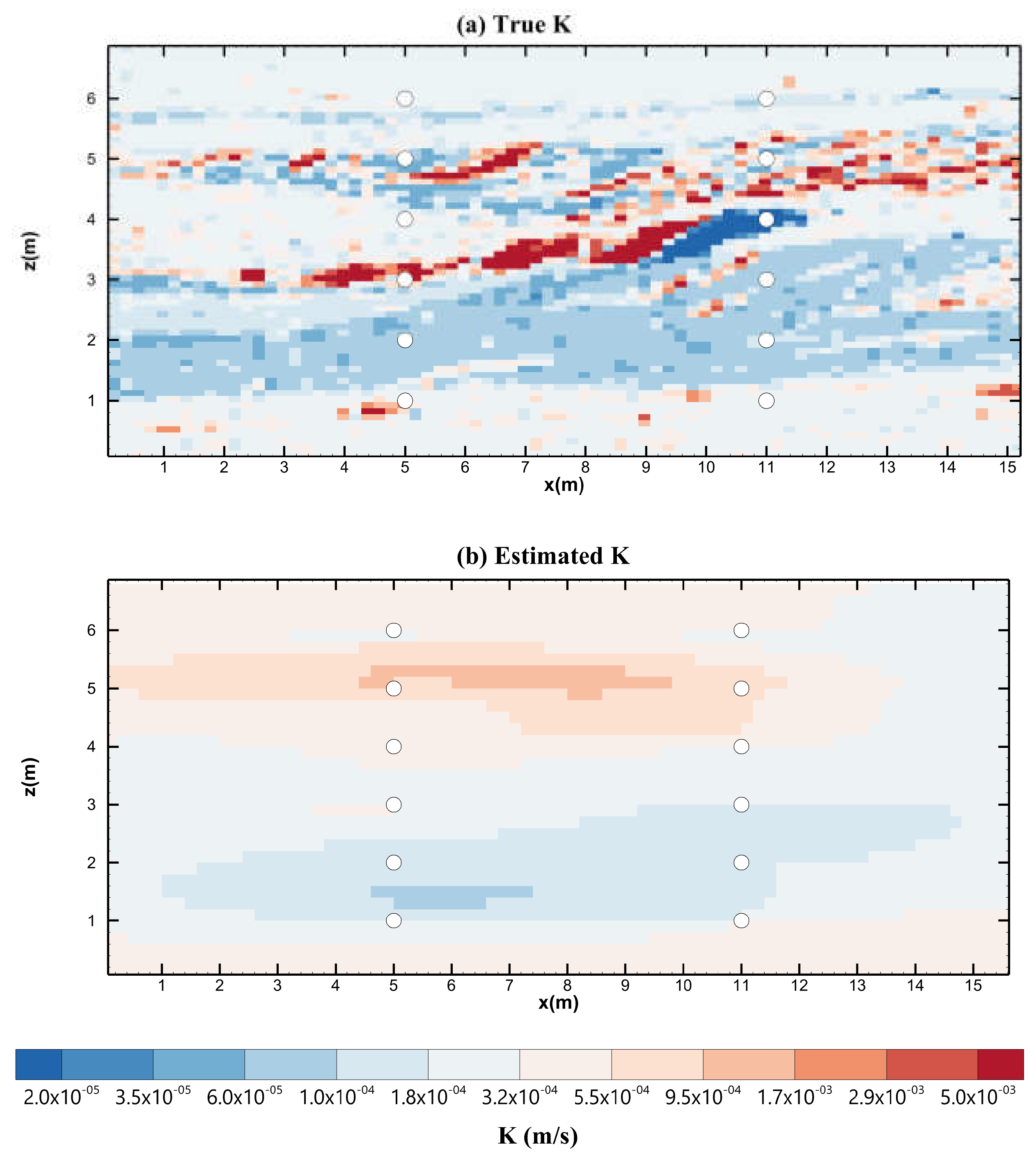
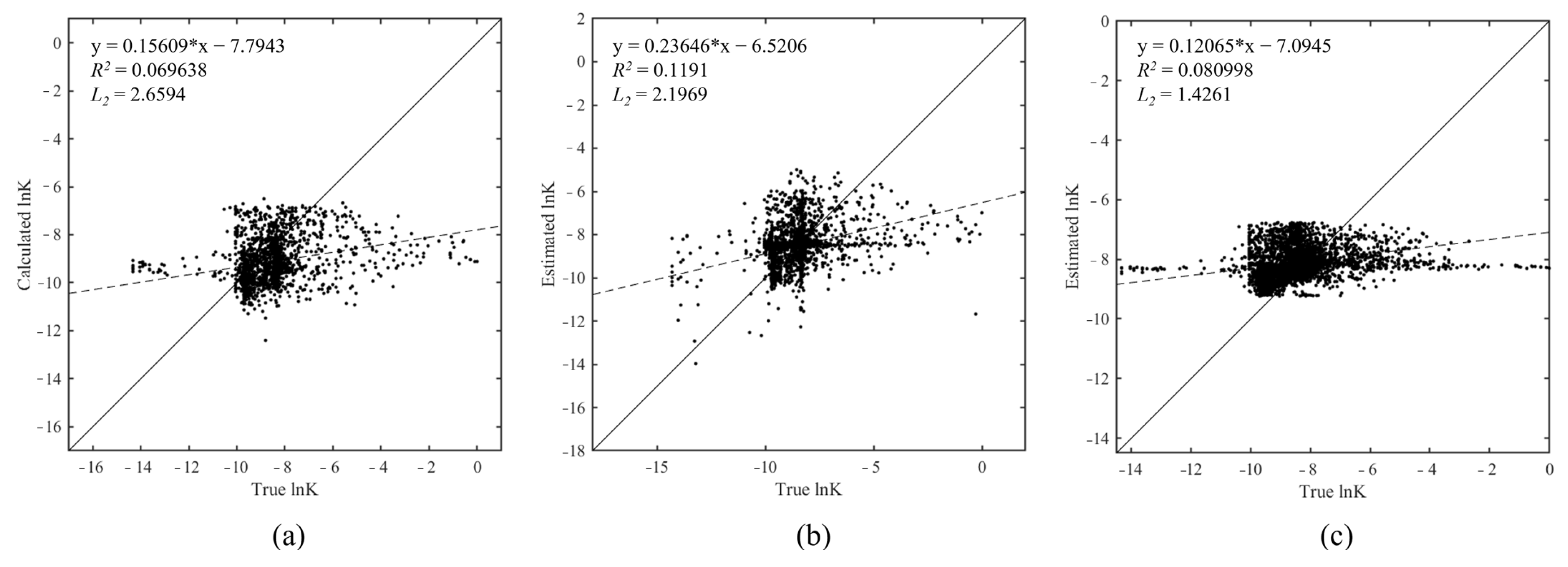
| Variable | Description | Value |
|---|---|---|
| Hydraulic conductivity of the homogeneous aquifer | 2.1 × 10−3 m/s | |
| Specific storage of the homogeneous aquifer | 6.6 × 10−5 m−1 | |
| Injection rate | 5 L/s | |
| Initial head of the confined aquifer | 0.2 m | |
| Ambient temperature | 20 °C | |
| Temperature of the injected water | 30 °C | |
| Parameters porosity | 0.5 | |
| Thermal retardation | 2.5 | |
| The hydraulic gradient | 0.1 |
| Hydraulic Travel Time and Attenuation Tomography | Thermal Tracer Tomography | Geostatistical Inversion | |
|---|---|---|---|
| Requirements | high-precision water head data | the injection water needs heating | pumping/injection needs to continue until head is stable |
| Advantages | low computational cost; low cost of testing time | low computational cost; less environmental noise in thermal signal | higher inversion resolution and broader inversion area |
| Disadvantages | calculated hydraulic conductivity contains more errors; environmental noise impact | requires a long testing time | high computational cost |
Disclaimer/Publisher’s Note: The statements, opinions and data contained in all publications are solely those of the individual author(s) and contributor(s) and not of MDPI and/or the editor(s). MDPI and/or the editor(s) disclaim responsibility for any injury to people or property resulting from any ideas, methods, instructions or products referred to in the content. |
© 2023 by the authors. Licensee MDPI, Basel, Switzerland. This article is an open access article distributed under the terms and conditions of the Creative Commons Attribution (CC BY) license (https://creativecommons.org/licenses/by/4.0/).
Share and Cite
Song, Y.; Hu, R.; Liu, Q.; Qiu, H.; Hou, X.; Qi, J.; Konadu-Amoah, B. Comparison of Hydraulic Travel Time and Attenuation Inversions, Thermal Tracer Tomography and Geostatistical Inversion for Aquifer Characterization: A Numerical Study. Water 2023, 15, 2401. https://doi.org/10.3390/w15132401
Song Y, Hu R, Liu Q, Qiu H, Hou X, Qi J, Konadu-Amoah B. Comparison of Hydraulic Travel Time and Attenuation Inversions, Thermal Tracer Tomography and Geostatistical Inversion for Aquifer Characterization: A Numerical Study. Water. 2023; 15(13):2401. https://doi.org/10.3390/w15132401
Chicago/Turabian StyleSong, Yang, Rui Hu, Quan Liu, Huiyang Qiu, Xiaolan Hou, Junjie Qi, and Bernard Konadu-Amoah. 2023. "Comparison of Hydraulic Travel Time and Attenuation Inversions, Thermal Tracer Tomography and Geostatistical Inversion for Aquifer Characterization: A Numerical Study" Water 15, no. 13: 2401. https://doi.org/10.3390/w15132401
APA StyleSong, Y., Hu, R., Liu, Q., Qiu, H., Hou, X., Qi, J., & Konadu-Amoah, B. (2023). Comparison of Hydraulic Travel Time and Attenuation Inversions, Thermal Tracer Tomography and Geostatistical Inversion for Aquifer Characterization: A Numerical Study. Water, 15(13), 2401. https://doi.org/10.3390/w15132401







